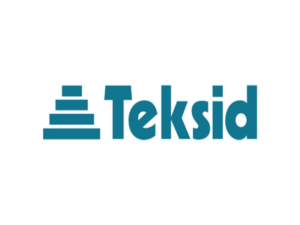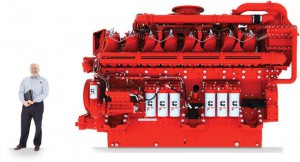
Citat från i somras .
Dr Riccardo Tarantini, President & Chief Executive Officer för Teksid S.p.A. “Eftersom den globala CGI-marknaden fortsätter att växa, är vi glada att investera i den senaste processtyrningsteknologin för CGI, för att kunna erbjuda våra kunder klassledande CGI-kunnande. Vi är fortfarande fast beslutna om att etablera Teksid som en av de ledande CGI-leverantörerna till den globala fordonsindustrin.”
Den 6 nov 2015 kom en PR
Teksid beställer sin tredje SinterCast-installation
08:01 / 6 november 2015
SinterCast System 3000 Plus kommer att installeras hos Teksid do Brasil
Utveckling av komponenter till bilar, tunga fordon och kraftindustrin Teksid erhåller CGI-produktionskunnande i Europa, Syd- och Nordamerika
[Torino, Belo Horizonte och Stockholm, 6 november 2015] -Teksid-koncernen har beställt sitt tredje SinterCast processtyrningssystem och etablerar sig därmed som den första gjuterikoncernen som har CGI-produktion på tre kontinenter. Enligt avtalsvillkoren ska ett SinterCast System 3000 Plus processtyrningssystem installeras i Teksid do Brasil-gjuteriet i Belo Horizonte, Brasilien. Installationen är planerad att tas i drift under det första kvartalet 2016 och kommer initialt att stödja produktutvecklingen av komponenter till bilar, tunga fordon och kraftindustrin.( det blev försenat till första kvartalet 2017 ) För att stödja framtida serieproduktion i stora volymer, valde Teksid do Brasil System 3000 Plus-teknologin, vilken ger automatisk basbehandling med tråd, SinterCast-patenterad termisk analys samt optimering av magnesium och ympmedelstillsats före gjutning. ”
——————————————–
Detta föregicks av
Teksid beställer sin andra SinterCast-installation
08:02 / 27 juli 2015
Mini-System 3000 kommer att installeras i Teksid Funfrap-gjuteriet, Portugal
Pågående produktutveckling av komponenter till bilmotorer
Planerad uppgradering till System 3000 Plus för serieproduktion
[Torino, Aveiro och Stockholm, 27 juli 2015] -I tillägg till det tekniska avtal som upprättades 2002 mellan Teksid-koncernen och SinterCast, har Teksid beställt ett andra processtyrningssystem för produktutveckling i kompaktgrafitjärn. Enligt avtalsvillkoren ska SinterCast installera ett processtyrningssystem Mini-System 3000 i Teksid Funfrap-gjuteriet i Aveiro, Portugal. Installationen är planerad att tas i drift under det tredje kvartalet och kommer att stödja pågående produktutveckling av motorblock till bilar samt andra motorkomponenter. Inför förväntad framtida serieproduktion kommer Teksid att utveckla och anpassa CGI-infrastrukturen och processflödet inför en planerad uppgradering till ett helautomatiskt System 3000 Plus.”
——————————–
29 nov 2012:
”Teksid uppgraderar sin kapacitet för serieproduktion i kompaktgrafitjärn
09:01 / 29 november 2012
* SinterCast System 3000 ska installeras i Teksids gjuteri i Monclova, Mexiko
* Pågående produktutveckling av applikationer för tunga fordon och industriell kraft
* Ytterligare CGI-expansion planerad för Teksid-gjuteriet i Belo Horizonte, Brasilien ( den kom nu i nov 2015)
[Torino och Stockholm, 29 november 2012] –
Teksidkoncernen har inlett produktutveckling i kompaktgrafitjärn (CGI) i programmen för tunga fordon och cylinderhuvuden inom industriell kraft, vid sitt gjuteri i Monclova, Mexiko. I förberedelserna inför serieproduktionsstarten, har Teksid beställt en helrenovering av sitt befintliga SinterCast processtyrningssystem, inklusive en uppgradering till nuvarande System 3000-standard. Det nya System 3000 har konfigurerats för att kunna tillgodose framtida produktionsvolymökningar i CGI, vilket innefattar ytterligare provtagningskapacitet och automatiserad basbehandling med tråd. System 3000 ska levereras ut från SinterCasts tekniska centrum i Sverige innan årets slut och installeras i början av 2013 för att möjliggöra oberoende produktutveckling och serieproduktion. För att möta ökad marknadsefterfrågan av CGI, planerar Teksid även att installera serieproduktionskapacitet för SinterCast-CGI vid sitt gjuteri i Belo Horizonte, Brasilien.” Det var denna som kom nu tre år senare
—————————–
Ni kan väl historien ? Det började redan för tretton år sedan 2002
SWEDEN: SinterCast sells CGI casting process control technology to Italy’s TekSid
http://www.just-auto.com/news/sintercast-sells-cgi-casting-process-control-technology-to-italys-teksid_id82947.aspx
July 26, 2002 – Turin and Stockholm Teksid Iron Foundries Adopt SinterCast Technology
Teksid, In response to the increasing momentum toward Compacted Graphite Iron (CGI) in the passenger car and commercial vehicle sectors, Teksid S.p.A. of Italy has entered into an agreement with the Swedish company SinterCast AB for the supply of CGI process control technology. The SinterCast System 2000 process control system will initially be installed at the Teksid iron foundry in Crescentino, Italy. Under the terms of the agreement, Teksid will be able to use the SinterCast technology at any of its nine iron foundries worldwide to support the CGI product development and production needs of its automotive customers.
”We have worked together with SinterCast since 1992 to produce CGI prototypes and to support the development activities of our customers”, said Dr. Riccardo Tarantini, General Manager of Teksid’s Cast Iron Foundries. ”Now, as the development activity of our customers intensifies, we are pleased to formalise our relationship with SinterCast and to install the System 2000 technology. We are committed to establishing Teksid as one of the leading CGI suppliers to the world automotive industry”.
Dr Steve Dawson, President & CEO of SinterCast said: ”The Agreement with Teksid again reinforces the industrial trend toward CGI and SinterCast’s position as the leading supplier of CGI process control technology. The collaboration with Teksid significantly broadens our ability to supply the CGI needs of the world automotive industry”.
Teksid Cast Iron Foundries are one of the largest independent iron foundry companies in the world with a combined capacity of its automotive foundries in Italy, France, Portugal, Poland, Brazil, Mexico and China of around 750,000 tonnes per year. The production that includes cylinder blocks, cylinder heads, exhaust manifolds, crankshafts, camshafts and suspension components for passenger and commercial vehicles is destined to the major customers worldwide such as Cummins, DaimlerChrysler, Deutz AG, FIAT GM Powertrain, Ford, GM, Honda, Iveco, Mack Truck, Nissan, Renault, Scania, Toyota, Volkswagen, Volvo. Teksid Cast Iron Foundries, is the only foundry company in the world to rank among the top 75 suppliers to the automotive industry, with annual sales of around USD 600 million (financial 2001).
SinterCast is the world’s leading supplier of automated on-line process control systems for the reliable high-volume production of CGI. With process control systems installed at eight foundries, including Caterpillar in the USA, Cifunsa in Mexico, Daros in Sweden, Halberg in Germany, ICC-International in the USA, SKF-Mekan in Sweden, Tupy in Brazil and VDP in Italy, SinterCast’s customers include Audi, Caterpillar, Daros Piston Rings, Ford, Rolls Royce Power Engineering and the SKF Group.
http://www.teksid.com/news.htm
————————————-
I en intervju 2002 i SvD sade Dawson lite om den just lämnade PR om Teksids första installation
Fråga & Svar Steve Dawson, vd Sintercast SINT +3,37%
O-listenoterade Sintercast Technologies har kammat hem en stororder från italienska industrikoncernen Teksid Cast Iron Business Unit. Ordern gäller ett processkontrollsystem för tillverkning av grafitjärn, även kallat CGI.
Vad betyder ordern för er, Steve Dawson, vd för Sintercast?
– Det är ett väldigt stort steg för Sintercast. Teksid är ett av de största gjuterierna i världen som tillverkar ungefär 12 procent av alla bilmotorer i världen.
Vad är den värd?
– Det är konfidentiellt. Men jag kan säga att vi både tjänar på att vi har sålt utrustning och på att Teksid använder den. Vi får inkomst för installationen och sedan från en löpande licens.
Hur länge då?
– För all framtid, licensavgiften är kopplat till produktionen. Det är så våra avtal ser ut.
Har ordern någon inverkan på er verksamhet?
– Det är inte så att vi behöver anställda personal nu, men ordern är ett budskap till marknaden att CGI är en växande industri. Vi har en bra position nu. Vi
har gjort investeringar under 12 år och nu börjar investeringarna ge resultat.
Vilka bilmotorer tillverkas i dag med CGI?
– Audi V8 har gjort det sedan 1999 och det är 3 500 motorer per år. Och Ford ska starta tillverkning av V6-diesel nästa år med CGI-teknologi.
Hur många blir det framöver?
– Ja, det tillverkas ju 40 miljoner personbilar varje år och genom att Teksid har 12 procent av marknaden betyder det att drygt 4 miljoner motorer kommer att tillverkas med Sintercasts CGI-teknologi årligen. Det är väldigt positivt för oss.
08-13 50 96, sara.larsson@svd.se
——————————————-
På Sintercasts hemsida.
Ask the President en vecka efter intervjun ovan i SvD
In an interview in Svenska Dagbladet, Steve Dawson was quoted as saying: ”There are 40 million cars made each year and with Teksid having a 12% market share it means that a little over four million engines a year will be made with SinterCast CGI technology. That is a very positive thing for us.” Is this true? Please clarify.
Shareholder, Hans Ågren
The Teksid agreement is indeed a very positive step forward for SinterCast. Teksid supplies approximately 12% of the world passenger car engine blocks, 11% of the heavy duty (truck) engine blocks and 7% of all truck cylinder heads. Whenever any of these Teksid products are converted to CGI they will automatically be made with the SinterCast technology. Together with the volumes secured through our other foundry partnerships, this puts SinterCast in a very strong position to supply the CGI needs of the world automotive industry. The reference to ¿four million engines per year¿ represents the potential of the Teksid agreement. The four million passenger car engines is the total production of all the Teksid iron foundries worldwide.
The foundry industry is very serious about capital investment. ( det finns alltså inget fog för att tro de bara installerar tre anläggningar för att det kan vara bra att ha. De har säkert en kund redan) They invest in technology, like the SinterCast System 2000 process control technology, to support the needs of their customers and to achieve a return on their investment. The decision by Teksid, and our other foundry partners, is a signal that CGI is coming and that SinterCast will be the preferred CGI technology provider
Steve Dawson
———————————
Hur stor kapacitet har EN av dessa anläggningar?
Det finns under Ask the President
How many tonnes per year can be produced using one SinterCast System 2000?

Shareholder, Charlie Persson
The standard Stand-Alone System 2000 has one Sampling Module (SAM) and is able to analyse one sample every four minutes. As the foundry production increases, we can add a second SAM to double the sampling capacity. In this way, the System 2000 can grow according to the production needs of the foundry. The System 2000 will not be the rate-controlling factor in the foundry production.
The limiting factor in a foundry is the speed of the moulding line and the flow of ladles from the melting area to the pouring area. Modern iron foundries for passenger car cylinder block production have a line speed of about 100 moulds per hour and produce about 10 ladles per hour. The ladles typically range from 1-3 tonnes in size. The System 2000 is able to satisfy these production requirements.
The actual production capacity of each moulding line is determined by the logistics of the foundry: number of moulds per hour; number of tonnes per ladle; number of shifts per day; number of production days per year. The end result can vary from 10,000 to 100,000 tonnes per year. Because of the large variation in ladle size and throughput it is impossible to draw any correlations between the number of SinterCast installations and the total production tonnage or annual revenue.
In our development laboratory in Katrineholm, we stress-test the software by automatically loading analysis files by computer. We can analyse one SinterCast sample every ten seconds which allows us to simulate the equivalent of a full year of production, about 25,000 ladles, in a single weekend.
1 ton= 20 ekv á 50 kilo
Nytt från Mortimer…………
Teksid set for high volume output of CGI?
Could the Teksid group be on the point of starting high volume production of compacted
graphite iron (CGI) components?
http://autoindustrynewsletter.blogspot.se/2015/11/teksid-set-for-higher-volume-output-of.html
WHY NOT?
Tesik kom med ett verkligt fin julklapp 2019
https://mb.cision.com/Main/15118/2973808/1161787.pdf
har redan startat
har Teksid-gruppen startat serieproduktion av kompaktgrafitjärn (CGI) vid sina gjuterier i
Monclova, Mexiko och Belo Horizonte, Brasilien.
TVÅ nya order redan
sade Dr Paolo Airaldi, vd från Teksid, S.p.A. ”Teksid-gruppen ser kompaktgrafitjärn som en av de viktigaste tillväxtmöjligheterna i industrin för gjutjärnsgjuterier















